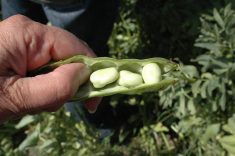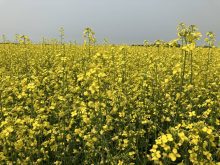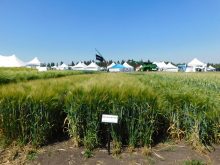This summer, plant pathologists have found a corn disease they’ve never seen in Alberta before — Goss’s wilt.
“We’ve confirmed the disease in two fields so far,” says Alberta Agriculture plant pathologist Mike Harding. “It doesn’t seem to have caused significant yield losses in those fields but we’re looking to see if it’s in other fields as well. Goss’s wilt isn’t always devastating, but it can be.
“We’re not really familiar with the disease yet, so we’re trying to learn as much as we can about it as quickly as we can.”
Read Also

New crop insurer policy enables easier startup for faba beans
Agriculture Financial Services Corporation updated its normals for faba beans, which may open the door for more Canadian producers to feel comfortable growing the pulse crop in the future.
The most common symptom of the disease is leaf blight — water-soaked streaks surrounded by tan to grey areas running lengthwise along the leaves that generally appear in mid-season. The lesion generally has a water-soaked central area and characteristic dark-green or black “freckles” in or just outside the lesion. The bacteria create an ooze on the leaf surface which dries to a shiny coating like varnish on the diseased area. Affected areas of leaf edges become wavy. Corn specialists say the blight looks like sun scald or drought stress, but the freckles and the shiny coating are unique to the disease.
Early-season infection with Goss’s wilt causes a systemic wilt. The plant’s vascular system is affected, limiting transport of water and nutrients and causing wilting and stunted growth. At first, vascular bundles within the stem become discoloured. The bacterial infection in the plants’ phloem and xylem tubes can progress to a slimy rot and eventually the death of the plant. Yield losses can be as much as 50 per cent.
The disease is caused by the bacteria Clavibacter Michiganensis subsp. Nebraskensis, which was first found in Nebraska in 1969. At first, it was limited to Nebraska and parts of Colorado, but more recently it has spread across the corn-growing areas of the U.S. In the last few years, it has hit corn in Manitoba’s Red River Valley and then other parts of the province. It did significant yield damage to Manitoba corn in 2009 and in 2011 about 80 per cent of crops showed some symptoms of the disease, but was hardly seen last year.
The pathogen overwinters in infested crop residue and can survive for a few years in the debris. Seed can carry the bacteria and may be the source of new infections. The disease is most often linked to infected crop residue and hail, sandblasting or wind damage that allows the bacteria access to plant tissues. Storms followed by wet or humid weather are ideal for the disease.
Because the disease is caused by a bacteria, there is no in-crop treatment for Goss’s wilt. It has to be prevented. Rotation into crops other than corn, but some grass weeds, including barnyard grass and green foxtail can act as hosts and allow the bacteria to persist in a field. Some hybrids are tolerant or resistant to the disease.
DuPont Pioneer has researched the disease and its management for more than 20 years, and claims leadership in managing the problem. The company has identified resistance genes.
Scott Heuchelin of DuPont Pioneer advises scouting throughout the season for Goss’s wilt.
“Infection can appear in two phases, early and mid-season,” he says. “It’s important to scout for Goss’s wilt throughout the season to see if your fields suffer from the disease and to manage against it over the long term. The disease can look like normal environmental stresses such as sun scald and drought stress, which makes scouting for it even more vital.”
Heuchelin advises harvesting affected fields last and cleaning all equipment after working in fields showing symptoms of Goss’s wilt. He also recommends tillage to bury residue and reduce survival of the bacteria.
Alberta Agriculture plant pathologist is surveying Alberta corn crops to assess the extent of Goss’s wilt infection in Alberta.














